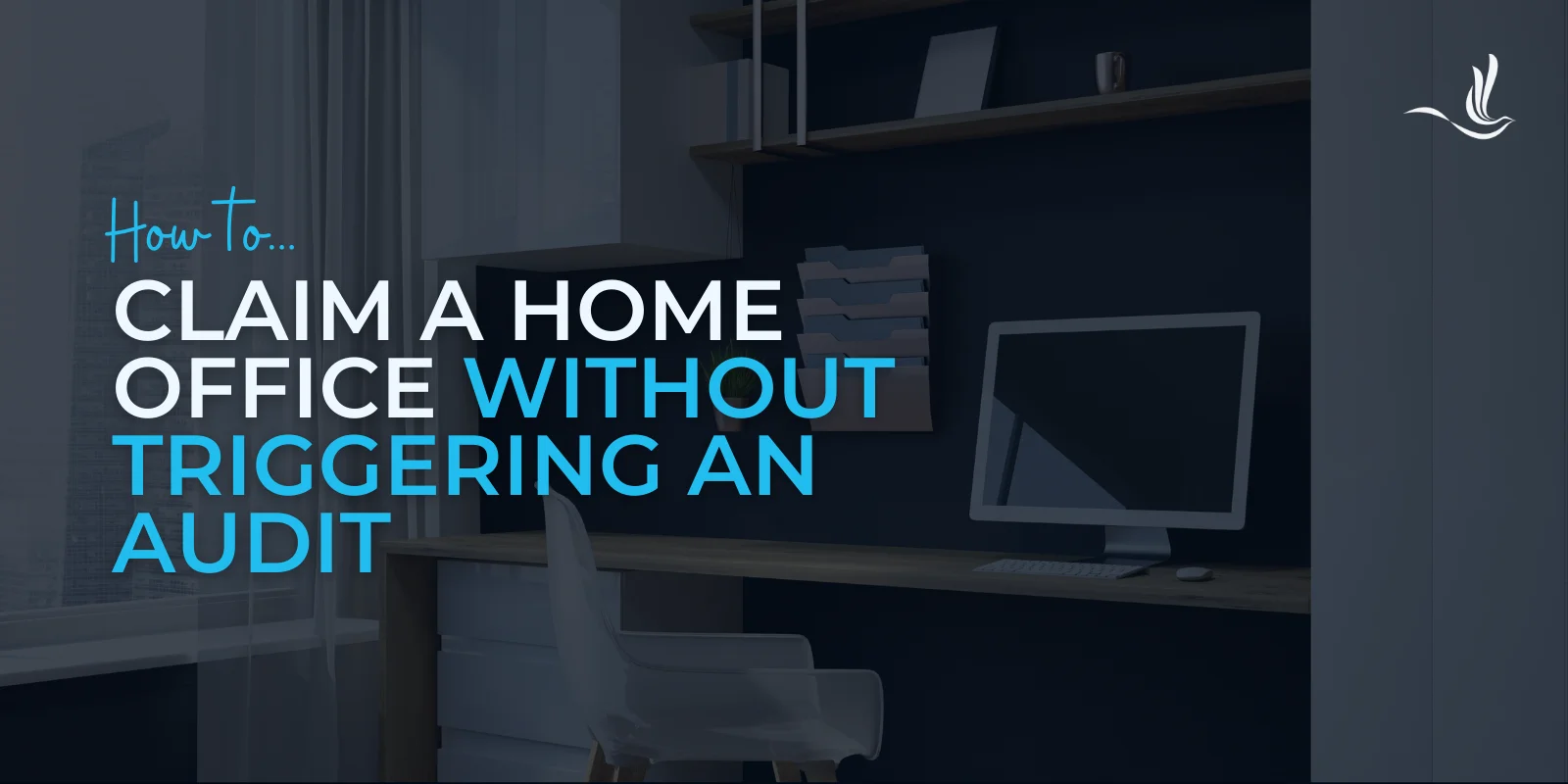Key Takeaways
The home office deduction does not automatically trigger an IRS audit if you qualify and follow the rules.
Only self-employed taxpayers (freelancers, contractors, small business owners) can claim the deduction while W-2 employees cannot.
To qualify, your workspace must meet the IRS exclusive and regular use test and function as your principal place of business.
Two calculation options exist: the simplified method (up to $1,500) or the regular method (percentage of actual expenses).
Common mistakes that raise red flags include overstating square footage, mixing personal expenses, and poor recordkeeping.
Maintaining accurate documentation and consistent use of your home office is the best way to stay audit-proof.
Remote work has gone mainstream and so has the home office deduction. For freelancers, small business owners, and self-employed professionals, it can be one of the most valuable tax breaks available. Yet, one question keeps surfacing every year: does the home office deduction trigger an audit?
The short answer is no. However, claiming a legitimate deduction for a qualifying home office does not automatically increase your chances of being audited. The IRS has repeatedly clarified that the deduction is safe to claim if you follow the rules. However, mistakes, overstatements, and poor recordkeeping can draw unwanted attention.
This guide breaks down everything you need to know about qualifying for the deduction, choosing the right calculation method, and keeping your tax return audit-proof.
Who Qualifies for the Home Office Deduction?
Not everyone can claim the home office deduction. Before calculating expenses, it’s essential to know if you meet the IRS requirements.
The most important distinction is between self-employed taxpayers and W-2 employees. Since the 2017 Tax Cuts and Jobs Act, employees who work remotely for an employer cannot deduct home office expenses, even if they work from home full-time. For instance, a self-employed graphic designer running her LLC from her apartment can claim the deduction, but a software engineer doing remote work for a major tech company cannot.
This deduction is designed for self-employed individuals, independent contractors, freelancers, and small business owners. Examples of eligible business types include:
Service providers (consultants, accountants, designers, tutors, writers)
E-commerce sellers who store products at home
Home-based childcare providers caring for children on-site
Real estate agents or sales reps who complete administrative tasks at home
If your business is legitimately run from your home and you meet the IRS tests, you may qualify.
The IRS “Exclusive and Regular Use” Test
The IRS sets a clear standard for what counts as a home office. Before claiming anything, you must pass the exclusive and regular use test. Exclusive use means your space must be used only for business purposes. A spare bedroom converted into a photography studio qualifies, but a kitchen table where you sometimes check emails while the family eats dinner does not.
Regular use means your home office should be used consistently, not sporadically. A den that doubles as a once-a-month bookkeeping station is not enough, but if you use that same den daily for client calls and managing orders, it satisfies the requirement. Meeting both tests is critical and misunderstanding them is one of the top mistakes that can draw IRS scrutiny.
What Counts as a Principal Place of Business?
Even if your space passes the exclusive and regular use test, it also needs to qualify as your principal place of business.
This doesn’t mean you must perform every business activity at home. What matters is whether your home office is where you handle the administrative or management side of your work. A contractor may spend most of the day at client job sites but still qualify for the deduction if all invoicing, scheduling, and client communications are run from a home office.
You can also have multiple work locations. For example, a realtor who shows homes throughout a city can still claim a home office deduction if her home workspace is the hub for drafting contracts and marketing. The IRS focuses less on where you deliver your service and more on whether your home office is essential to managing your business.
Special Cases: Childcare & Storage Facilities
The IRS provides special rules for certain businesses that don’t fit the strict exclusive-use test.
Home Daycare Providers
Childcare providers can deduct the portion of their home used for daycare during business hours, even if the same space becomes personal living space after hours. A living room filled with play mats and toys during the day can still qualify, despite being used by the family in the evening.
Inventory and Product Storage
Online retailers or product-based businesses may qualify even if the space isn’t exclusively used for business. An Amazon seller who uses half of the garage for storing boxes and shipping supplies can claim that portion as a business expense. This rule reflects the IRS’s understanding that some business models require flexible home use.
Choosing the Right Calculation Method
Once you know you qualify, the next step is figuring out how to calculate your deduction. The IRS offers two approaches: the simplified method and the regular method.
Simplified Method
The simplified option allows you to deduct $5 per square foot of office space, up to 300 square feet. The maximum deduction is $1,500. Key items to keep in mind for the simplified method are:
No home depreciation deduction for this method
No complex recordkeeping
Best for smaller offices or those seeking simplicity
For example, a freelance writer working in a 200-square-foot home office could claim $1,000 without needing receipts for utilities or repairs.
Regular Method
The regular method calculates the deduction based on the percentage of your home used for business. Both direct and indirect expenses apply here:
Direct expenses (painting or repairing the office itself) are fully deductible.
Indirect expenses (utilities, mortgage interest, rent, insurance, repairs to the overall home) are deductible in proportion to business use.
This method often leads to larger deductions but requires detailed recordkeeping and filing Form 8829. For example, a self-employed therapist using 20% of her home for counseling sessions could deduct 20% of her mortgage interest, property taxes, and utility bills.
Comparing Both Methods
The simplified method is quick and capped at $1,500, making it ideal for those with smaller offices or fewer expenses. The regular method, on the other hand, can yield significantly larger deductions, especially for homeowners with high housing costs or bigger workspaces. However, this method requires more paperwork and recordkeeping. The good news is that you can decide which method to use each year, allowing you to choose whichever option maximizes your tax benefit.
How to Calculate Your Deduction (Step-by-Step)
First, measure your home office space. If your office is 150 square feet within a 1,500-square-foot home, then 10% of your home is used for business.
Next, allocate expenses properly. Under the regular method, 10% of your electricity bill and 10% of your mortgage interest would be deductible. If you repaired a window in your office, that’s a direct expense and fully deductible.
Then, apply the method you choose. Under the simplified method, multiply your square footage by $5. Under the regular method, apply your business-use percentage to all expenses and report them on Form 8829. With the simplified method, you simply enter the amount on Schedule C.
Common Mistakes That Trigger IRS Scrutiny
The home office deduction itself doesn’t increase your audit risk, but certain mistakes can catch the IRS’s attention. Understanding these pitfalls will help you claim the deduction with confidence.
Claiming Personal Spaces as Business Use
One of the most common errors is attempting to deduct areas that serve both personal and business functions. The IRS requires exclusive business use, so multipurpose spaces typically don’t qualify. For instance, a dining room where your family eats dinner but where you also work on your laptop cannot be claimed. Even using a guest bedroom part-time as an office may fail the test if it’s occasionally used by visitors.
Overstating Square Footage
Another frequent misstep is inflating the size of your office to maximize the deduction. If your office is 150 square feet, you should not round up to 300 square feet just to claim the maximum under the simplified method. The IRS expects accurate, reasonable measurements. A sudden jump in square footage claimed from one year to the next without a clear explanation, like moving to a larger office, could raise questions.
Mixing Personal and Business Expenses
It’s easy to overreach when allocating expenses. While indirect costs like utilities, rent, or mortgage interest can be partially deducted, you must only deduct the portion directly tied to business use. For example, your internet bill must be split based on business versus personal usage, not deducted in full unless the service is strictly for your office. Similarly, repairs to the kitchen or living room aren’t deductible just because you work from home. They must relate directly to your office space or be applied proportionally as whole-house expenses.
Failing the “Exclusive and Regular Use” Test
Some taxpayers misunderstand the exclusive and regular use requirement. Occasional work from a couch or dining table doesn’t meet the IRS standard. Your workspace must be consistently dedicated to your business. For example, a graphic designer who uses a dedicated 100-square-foot studio daily for client projects qualifies, but someone who checks work emails once a week in the living room does not.
Poor Recordkeeping and Lack of Documentation
Perhaps the most audit-triggering mistake is failing to keep proper documentation. The IRS doesn’t just want to see numbers, they want proof. This includes receipts for utilities, mortgage statements, repair invoices, and even photos or floor plans of your home office. Without documentation, you’ll have little defense if your return is questioned. Good records also help explain year-to-year changes, such as moving to a larger office or making significant renovations.
Audit-Proofing Your Deduction
The best defense against an audit is preparation. The IRS isn’t out to punish legitimate claims, but they do expect accuracy and proof. Keep detailed records such as utility bills, mortgage statements, and repair receipts. Take photos of your workspace or maintain a simple floor plan showing business use. If your deduction percentage changes significantly from year to year, be ready to explain why. For instance, if you moved to a larger home office.
What Happens if My Home Office is Audited?
If the IRS audits your home office deduction, it can happen through the mail or in some cases through an in-person interview. You’ll need to provide proof such as receipts for utilities, mortgage interest, rent, repair invoices, or insurance, along with evidence of your office space. Photos, floor plans, and even a simple written description of how the area is used exclusively and regularly for business can strengthen your case
The key during an audit is to demonstrate that your claim is reasonable and backed by consistent records. If you’ve measured your office correctly, applied expenses accurately, and kept documentation organized, the IRS is likely to accept your deduction. On the other hand, inflated square footage or missing receipts can complicate matters. Remember, the IRS is less concerned with the fact that you claimed the deduction and more focused on whether you can prove it.
Frequently Asked Questions About Home Office Deductions
Can I write off my internet bill if I work from home?
Yes, you can deduct the business portion of your internet bill if you use it for work. Only the percentage directly tied to your home office is deductible, not the portion that is meant for personal use.
Can I deduct homeowners insurance for a home office?
Homeowners insurance is deductible as part of indirect expenses under the regular method. You can claim the portion that corresponds to your home office’s percentage of total square footage.
How do I prove my home office is tax deductible?
You can prove your deduction by maintaining receipts, utility bills, mortgage or rent statements, and records of repairs. Photos or floor plans showing the dedicated workspace also strengthen your documentation.
What are common mistakes with home office deductions?
Frequent mistakes include claiming personal spaces as business use, overstating square footage, mixing personal and business expenses, and failing to keep proper records. These errors increase audit risk.
What are the disadvantages of claiming home office on taxes?
The main disadvantages are extra recordkeeping, more complex tax filings with Form 8829, and the risk of IRS scrutiny if rules aren’t followed. However, when claimed correctly, the deduction is safe and valuable.
What expenses can I claim for a home office?
You can claim direct expenses like office repairs and paint, and a percentage of indirect costs such as rent, mortgage interest, utilities, property taxes, insurance, and Internet service, depending on the calculation method you choose.
Tax Help for Small Businesses
Claiming the home office deduction doesn’t have to feel risky. As long as you meet the IRS rules, calculate your expenses accurately, and keep good records, you can take advantage of this valuable tax break without worrying about triggering an audit. The key is to be precise and consistent with your documentation. Your home office should truly function as part of your business, and your paperwork should back that up. Optima Tax Relief is the nation’s leading tax resolution firm with over a decade of experience helping taxpayers.
If You Need Tax Help, Contact Us Today for a Free Consultation



























